The Hebesphenomegacorona
The hebesphenomegacorona is the 89th Johnson solid (J89). Its surface consists of 21 regular polygons (18 triangles and 3 squares), 33 edges, and 14 vertices.
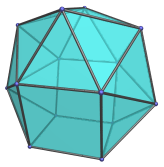
The hebesphenomegacorona is one of the special Johnson solids at the end of Norman Johnson's list that are not directly derived from the uniform polyhedra by cut-and-paste operations. As Norman Johnson explains, a lune is a square with two opposite edges attached to equilateral triangles, and a spheno (Latin for wedge) complex is two lunes joined together to form a wedge-like structure. A hebespheno complex is a larger, blunter complex of three lunes. A corona is a crown-like complex of 8 triangles, whereas a megacorona is a larger corona with 12 triangles. Hebesphenomegacorona, therefore, describes the structure built from a hebespheno complex attached to a megacorona of 12 triangles.
Projections
Here are some views of the hebesphenomegacorona from various angles:
| Projection | Description |
|---|---|
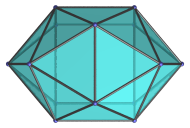 |
Top view. |
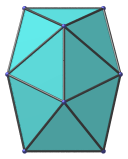 |
Front view. |
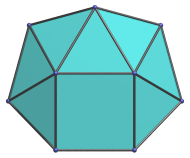 |
Side view. |
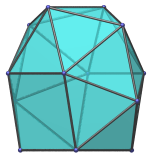 |
45° side view. |
Coordinates
The Cartesian coordinates of the hebesphenomegacorona with edge length 2 are:
- (±1, ±1, 2B)
- (±1, ±(1+2A), 0)
- (±(1 + C/√(1−A)), 0, −(2A2+A−1)/B)
- (0, ±1, −D)
- (±(DC+E)/(FE), 0, ((2A−1)D)/F − C/(FE))
where:
- B = √(1−A2)
- C = √(2(1−2A))
- D = √(3−4A2)
- E = √(1+A)
- F = 2(1−A)
and A is the root of the following polynomial between 0.2 and 0.22:
26880A10 + 35328A9 − 25600A8 − 39680A7 + 6112A6 + 13696A5 + 2128A4 − 1808A3 − 1119A2 + 494A − 47 = 0
The approximate value of A is 0.216844815713457.
Credits
The above coordinates were adapted from the solution published by
A. V. Timofeenko (2008), The non-Platonic and non-Archimedean
noncomposite polyhedra
, Fundamentalnaya i Prikladnaya Matematika,
vol.14 (2), pp.179-205. (А. В. Тимофеенко (2008)
«Несоставные многогранники, отличные от тел Платона и Архимеда»,
Фундаментальная и Прикладная Математика, том 14-й (2),
ст.179-205.)
An error in the printed coordinates of the last set of vertices in the paper was corrected: a factor of 2 in the denominator of the first term in the last coordinate was misprinted as 4, thus effectively turning ((2A−1)D)/F into ((2A−1)D)/(2F). This error appears to be a mere typo; the derivation itself is correct, and the correct coordinates can be derived from it. This correction was pointed out by Loïs Mignard.




